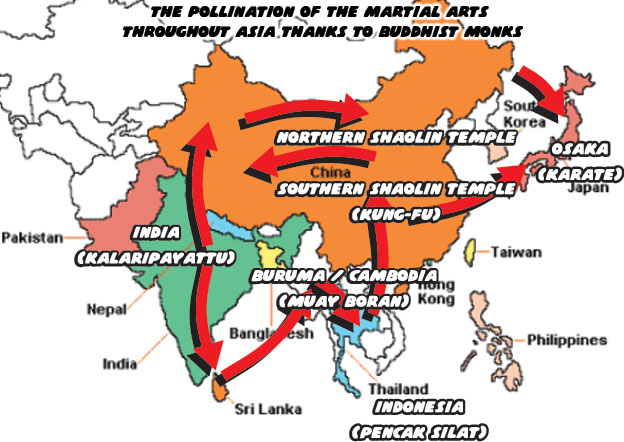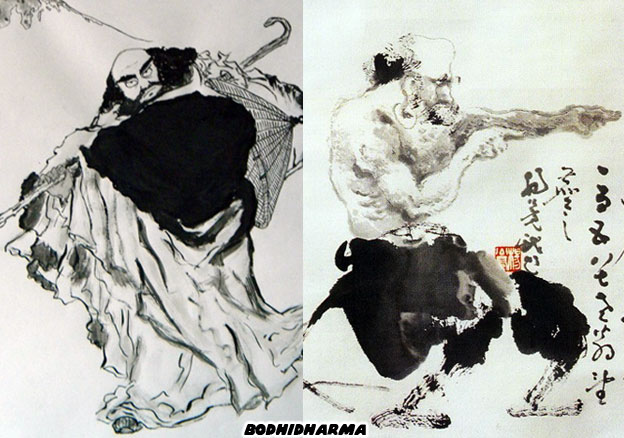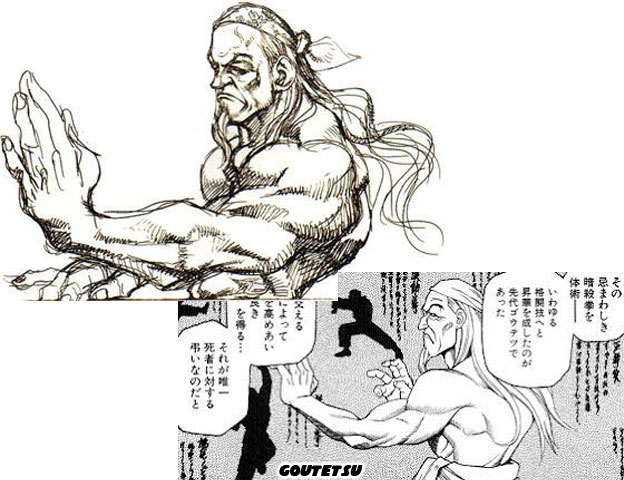Normally I start a fighting game series in the early 20th century but this time around we are going back more than a millennia. It is understood that the roots of the Asian martial arts stem from China. Even the popular forms of karate and tae kwon do from japan and Korea respectively have roots in Chinese martial arts. Yet how did those styles get introduced to different nations? How did they evolve? What differences did they carry? Is there any sort of common ancestry? The answer to that is actually rooted in the spiritual beliefs from India.

Buddhism, as a path towards finding enlightenment began in the heart of India over 1500 years ago. The system spread throughout Asia over the next 1000 years. It travelled north and south via monks and disciples. It crossed boundaries and nationalities and became ingrained with the art, language and culture of every place it visited. The symbols of Buddha were adapted and refined to fit the customs of local tribes. Whether they lived in the Himalayan mountains or in the monsoon belt of the Southeast Asian peninsula the followers of Buddha tried to reflect the lessons and remain ever vigilant against worldly corruptions. This meant that many practitioners had to learn how to strengthen their mind, body and resolve as to not give into temptation. A series of exercises was developed to help monks maintain focus and protect themselves and their communities wherever they travelled. These early forms of fighting were rooted in the Indian fighting art Kalaripayattu. It was the predecessor to Kung-Fu and Karate. The person that was most influential to the spread of the martial arts and Buddhism throughout China was a man named Bodhidharma. He was described as a dark skinned man that was treated rather unkindly by Chinese villagers. They were suspicious of foreigners, even if they professed to be spiritual men. Little by little he won over their trust and eventually respect by sharing his insight and instructing the early Shaolin Buddhists in the arts of self-defense.
In Mainland China kung-fu is more commonly known as kempo or whushu. It is well known and understood as one of the oldest forms of fighting on the face of the Earth. Take the description of one of the oldest forms, Shorinji Kempo, into account. According to this webpage highlighting the various forms of martial arts.
"Shorinji Kempo traces its origins back almost 5000 years to India. From India, Buddhism spread to many countries, including China. Bodhidharma, the sixth century founder of Zen Buddhism, introduced kempo to the legendary Shaolin Temple ('Shorin-Ji' in Japanese), located in Honan prefecture. Here kempo became the main form of spiritual training for the buddhist monks and the monastery became famous for its fighting arts. Wall paintings can still be seen today in the Shaolin Temple of dark-skinned (Indian) monks practicing and teaching kempo to light-skinned (Chinese) monks. The Imperial Chinese Government, feeling threatened, destroyed the temple and persecuted the monks. The techniques however continued to be taught and practiced by various secret societies as a means of protection against bandits and corrupt officials. Many different forms of kempo were developed and kept alive by these secret societies."

Bodhidharma had introduced physical exercises to the Shaolin monks to strengthen their bodies and minds. He wrote the manuscripts which established the physical regiments that the monks were expected to adhere to and even a book on dieting to achieve the maximum results from exercise. His manuscript Included a diet of teas which would help the monks focus and concentrate during long meditation sessions. It was said that Bodhidharma became enraged with himself when he fell asleep during his meditation and created the manuscripts so that his physical body would no longer fail him. The manuscripts disappeared over the centuries but many of the fighting techniques that he taught, including the use of the staff, survived to this day. Bodhidharma became synonymous with the martial arts and became a symbol for its lineage.
When Buddhism arrived in Japan and mixed with Shinto traditions the personification of Bodhidharma became almost subversive. He was dark and brooding, the polar opposite of the white and chaste symbols of divinity and purity in ancient Japan. His influence, especially in the martial arts seemed primitive, almost backwoods. There was no denying its effectiveness however, the early practitioners of the martial arts in Japan were immigrants that had arrived from China. Before Karate became synonymous with the "Empty Hand" techniques it was instead known as "China Hand" in Japanese. The original martial arts masters in Japan had brought with them the techniques that Bodhidharma coveted. In Japanese pop culture this lineage would be celebrated again and again in the manga, or comic books, that told the stories of turn-of-the century masters. The character Goutsetsu, the master of Gouki and Gouken from Street Fighter mythology was Chinese. He had brought with him the secret techniques of an "Assassins Fist" or Ansatsuken from China and trusted his students with them.

The influence that Buddhism had throughout Asia was immeasurable. It went well beyond what Bodhidharma did for the martial arts. Systems of fighting had been around since recorded history. The bigger the civilization was the more likely it had several forms of fighting taught in each provence. Some styles were created for military conquest and some for sport. What Buddhism did was cross pollenate spirituality, culture and the martial arts throughout Asia. As the Buddhist monks went from village to village they adapted the customs and art of the locals. They traded symbology and philosophy with many spiritual leaders and traded blows with bandits that attacked them on their travels. If you were to study the history of the martial arts you would actually see how certain systems predated others and how some forms were based on older schools. The oldest forms began in India and progressed east. It was no accident that the rise in martial arts ran parallel with the spread of Buddhism.
In a thousand years the fighting forms that would withstand the test of time had developed along the roads taken by merchants and travelers but especially by monks. By the time the monks reached the Sea of Japan they had brought with them countless lessons from their travels. The closest point between the Asian mainland and the main island of Japan was from a peninsula of what was now known as South Korea. Early immigrants from China and Korea, some monks and some merchants crossed the channel and settled in the center of Japan. The largest town being Osaka, where the seeds of what would become Karate were planted. Before we cross the channel ourselves this blog will take its time and see how various fighting arts were created and how they were represented in pop culture, but specifically in video games. As always if you enjoyed this blog and would like to sponsor me please visit my Patreon page and consider donating each month, even as little as $1 would help make better blogs and even podcasts!

No comments:
Post a Comment